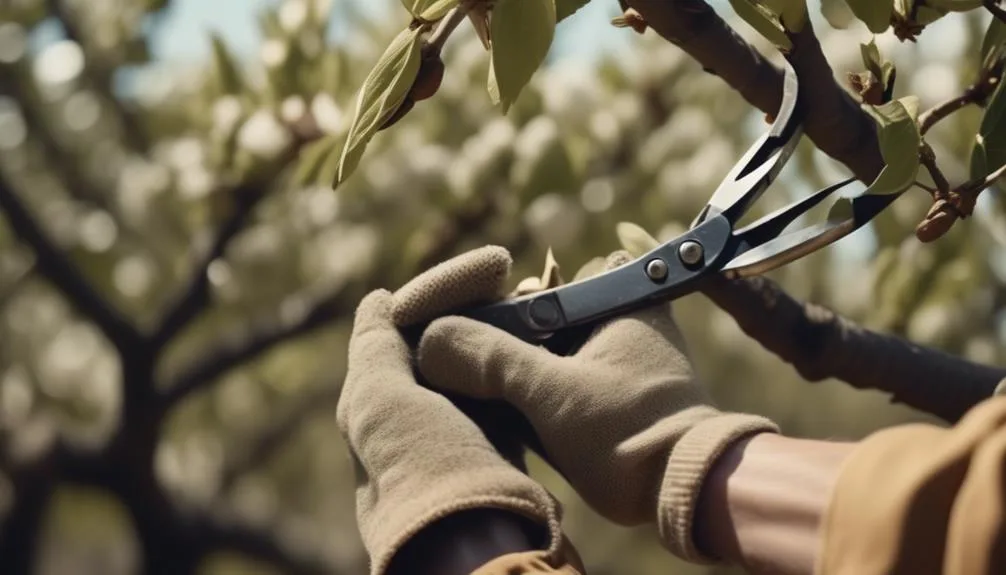Pruning almond trees can be daunting, but it's crucial for their growth and productivity. Understanding the right timing, tools, and techniques is key.
Whether you're new to gardening or experienced, mastering the art of pruning almond trees is essential. Let's explore the secrets to successful almond tree pruning in a simple, easy-to-understand way.
Key Takeaways
- Prune almond trees during the dormant season in late winter or early spring to promote healthy growth and improve overall yield.
- Use essential tools such as pruning shears and loppers for cutting small branches and thicker branches respectively.
- Pay attention to the branch structure when pruning and remove dead, diseased, crossing, or rubbing branches to encourage new, healthy growth and better air circulation.
- Regularly prune almond trees to remove dead or diseased branches, water sprouts, and crowded or crossing limbs, and to manage the tree's size and shape for overall health and high-quality almond production.
Timing for Pruning Almond Trees
When pruning almond trees, the ideal timing for this task is during the dormant season in late winter or early spring. This period is the optimal time for almond tree pruning as it allows the trees to heal before the growing season begins. Pruning during this time helps to promote healthy growth, maintain tree shape, and improve overall yield.
It's essential to avoid pruning during the rainy season to prevent disease and fungal infections. Additionally, pruning during the dormant season minimizes stress on the trees and reduces the risk of sap bleeding.
Tools Needed for Pruning
You'll need a few essential tools to effectively prune almond trees during the dormant season. Pruning shears and loppers are the primary tools required for proper pruning.
Pruning shears are perfect for cutting small branches and twigs, while loppers are ideal for thicker branches. When selecting pruning shears, opt for bypass pruners as they provide a cleaner cut, promoting faster healing for the tree. For loppers, choose ones with sharp blades and extendable handles for reaching higher branches.
Remember to clean and sharpen your tools before pruning to prevent the spread of diseases. It's important to use the right tools and follow proper pruning techniques to avoid common mistakes that can harm the tree.
With the right tools and techniques, you can ensure the health and vitality of your almond trees.
Techniques for Pruning Almond Trees
To effectively prune almond trees, it's essential to master a few key techniques that will promote healthy growth and fruit production. When pruning almond trees, pay attention to the branch structure. Remove dead or diseased branches, as well as any that are crossing or rubbing against each other. This encourages the growth of new, healthy branches and ensures an open canopy that allows for better air circulation and light penetration.
Additionally, proper pruning techniques can aid in disease prevention by removing potential areas for pathogens to thrive. Make clean cuts close to the collar of the branch without leaving stubs, which can attract pests and disease.
Pruning Young Almond Trees
Mastering the techniques for pruning almond trees will prepare you to effectively shape and care for young almond trees, ensuring their healthy growth and optimal fruit production. When it comes to pruning young almond trees, there are important factors to consider:
- Establish a strong central leader: Encourage the growth of a central leader by identifying the strongest, most vertical shoot and pruning away any competing leaders.
- Maintain a balanced scaffold: Select 3-5 lateral branches evenly spaced along the central leader and prune away any competing or poorly positioned branches.
- Manage branch angles: Aim for wide crotch angles (45-60 degrees) to promote strong, resilient branch structure.
- Promote airflow and light penetration: Remove any crowded, crossing, or inward-growing branches to ensure proper airflow and light distribution throughout the tree.
Maintenance Pruning for Almond Trees
When maintaining almond trees, it's essential to regularly prune to encourage healthy growth and ensure the continued production of high-quality almonds. Maintenance pruning should focus on removing dead or diseased branches, water sprouts, and crowded or crossing limbs. This helps improve air circulation and sunlight penetration, reducing the risk of diseases and promoting even fruit development.
Additionally, it's important to manage the tree's size and shape through selective pruning to maintain its structural integrity and facilitate harvesting. Aim to keep the center of the tree open to sunlight and airflow, which is crucial for overall tree health.
Regular maintenance pruning not only enhances the appearance of the almond orchard but also supports the tree's productivity and longevity. Remember, proper almond tree care through maintenance pruning is key to a bountiful harvest.
Conclusion
Incorporating the proper timing, tools, and techniques for pruning almond trees will ensure their healthy growth and productivity.
From establishing a strong framework for young trees to regular maintenance pruning, your almond trees will thrive and yield bountiful harvests for years to come.
Happy pruning, and may your orchard flourish with the care it deserves.


1 Comment
I planted 2 almond trees about 13 years ago. I haven’t ever pruned them. Should I prune them excessively?